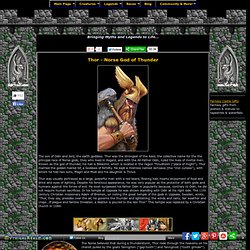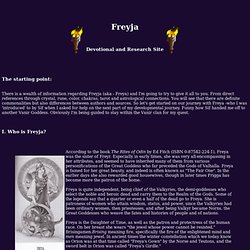

Norse Mythology. Norse mythology. An undead völva, a Scandinavian seeress, tells the spear-wielding god Odin of what has been and what will be in Odin and the Völva by Lorenz Frølich (1895) For the practices and social institutions of the Norse pagans, see Norse paganism Norse mythology, or Scandinavian mythology, is the body of mythology of the North Germanic people stemming from Norse paganism and continuing after the Christianization of Scandinavia and into the Scandinavian folklore of the modern period.

The northernmost extension of Germanic mythology, Norse mythology consists of tales of various deities, beings, and heroes derived from numerous sources from both before and after the pagan period, including medieval manuscripts, archaeological representations, and folk tradition. Most of the surviving mythology centers on the plights of the gods and their interaction with various other beings, such as humanity and the jötnar, beings who may be friends, lovers, foes and/or family members of the gods.
Sources[edit] Thor, God of Thunder: Viking Norse Myth Legend :Norse Mythology, Lady Gryphon's Mythical Realm. The son of Odin and Jord, the earth goddess.

Thor was the strongest of the Aesir, the collective name for the the principal race of Norse gods; they who lived in Asgard, and with the All-Father Odin, ruled the lives of mortal men. Known as the god of thunder, his hall is Bilskirnir, which is located in the region Thrudheim ("place of might"). Thor married the golden-haired Sif, a Goddess of fertility. He kept a mistress named Jarnsaxa (the "iron cutlass"), with whom he had two sons, Magni and Modi and his daughter is Thrud. Thor was usually portrayed as a large, powerful man with a red beard, flowing hair, hearty enjoyment of food and drink and eyes of lighting. The Norse believed that during a thunderstorm, Thor rode through the heavens on his chariot pulled by the goats Tanngrisni ("gap-tooth") and Tanngnost ("tooth grinder"). Thor was very well-known for his quick and hot temper. Thor has lived on, not as a part of any religion, but on our weekly calendar. The Goddess Freyja - Norse Deity.
***According to Norse Mythology - The Myths and Legends of the Nordic Gods by Arthur Cotterell, Freyja is the daughter of the sea god Njord and sister of Freyr.

She is an important fertility goddess and a member of the Vanir, one of the 2 branches into which the Germanic gods were divided. After a war the Vanir seem to have been supplanted by the younger Aesir, who were led by Odin. When peace was agreed between the two sides, Njord went with Freyr and Freyja to Asgard, where they lived with the Aesir as a token of friendship.
Both Odin and Freyja took an interest in the heroic dead, dividing the slain between them at the end of every battle. Odin's share went to live in Valhalla, while Freyja's lived in her hall, Sessrumnir. Freyja flew over the earth, sprinkling morning dew and summer sunlight behind her. It is possible that Freyja's lost husband Odur, or Od, of whom nothing is known but his name, was in fact Odin. Freyja's greatest treasure was the Brisings' necklace. Timeless Myths: Norse Mythology. Einstein. Imagining the Tenth Dimension - A Book by Rob Bryanton. Wave Theory blazelabs : Messages.